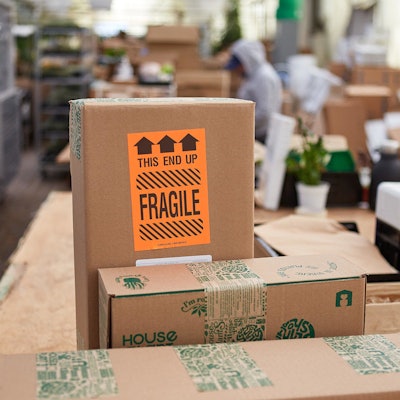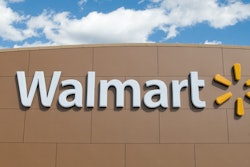
A pair of childhood friends and eventual post-college roommates once were uniquely interested in livening up their home with house plants. But they were disappointed when they found it hard to find a place online to purchase houseplants that was easy to navigate, and wasn’t just geared to wholesale.
So in 2017, Andy Burde and Tristan Schmitt founded House Plant Shop with the intent to become a destination for consumers to purchase house plants directly from the web. First launching under the main House Plant Shop brand, House Plant Box monthly subscriptions followed not long after, in late 2018.
Originally working out of the small house they shared, HousePlantShop.com and HousePlantBox.com have now grown to occupy large, well-equipped greenhouses based in southern California and central Florida. Today, the company also uses a network of growers, alongside those in-house greenhouse operations, to work with retailers to offer a large selection of indoor foliage. Meanwhile, another business unit, House Plant Wholesale, can assist in reducing cost and growing indoor foliage sales, including drop-shipping and gifting services, from sourcing and storing plants to transporting large quantities nationwide. But as almost always the case, as the House Plant family of businesses grew, transportation issues began to affect profit.
“Most plants are inexpensive to purchase, but the shipping costs can be quite high. When plants get damaged in transit due to inadequate packaging, that is when our margins are affected,” says Schmitt, COO. “So having a low damage rate, specifically aiming towards less than 10%, is very important to us. If the product arrives damaged, we will have to refund the customer or send them a new one which impacts margins significantly over time.”
Plus, House Plant ships across the country so keeping the plant upright and secure in transit is a priority, especially if it’s shipping a multi-pack with 20 to 30 plants. And as stands to reason, maintaining the health of the plan is a challenge when transit via FedEx and USPS can take up to three days.
“There is always room for improvement when shipping live plants, but it has to be cost effective. Once we reached a certain volume of orders it became worthwhile to look into custom solutions with the help of a partner like Veritiv,” Schmitt says.
From off-the-shelf to a custom solution
House Plant initially had been using standard corrugated boxes from another vendor, but the founders say they were expensive and didn’t fit the specific products’ needs, contributing to damage. The company also wanted to reduce its SKUs to maximize limited dry storage in a dry room—a temperature- and humidity-controlled environment used to preserve the plant before it is shipped. Dry storage is a costly real estate investment which means the company prefers to maximize the space for its plants.
“Prior to finding Veritiv, we ... were limited to stocked items,” says Schmitt. “We had heard good things about Veritiv from other businesses and decided to reach out for our packaging needs. When we started working with them, they helped us through every step of the development and production of our packaging, and we have been very pleased with the outcome. Veritiv helped us by creating a customized package that fit our products more securely, cut our box SKUs in half, and in the end was cheaper than [the legacy packaging supplier].” The items are delicate, and the packaging solution must transition from summer to winter without having to swap between multiple solutions. To do this, Veritiv and House Plant focused on strength of the package around the base of the plants. This ensured the plants were stable and protected when they were stacked on one another and when we place multiple plants in one box.
The items are delicate, and the packaging solution must transition from summer to winter without having to swap between multiple solutions. To do this, Veritiv and House Plant focused on strength of the package around the base of the plants. This ensured the plants were stable and protected when they were stacked on one another and when we place multiple plants in one box.
Beyond the custom packaging with secure fitting, the new solution scratches a host of other itches.
“Our packaging is paper-based, and we try to avoid single-use plastic within our entire supply chain,” Schmitt says. “We also wanted to optimize space within a larger package to fit more products in one space. To do this, we added a second set of tabs on the other end of the box so that we could now fit two plants and pots on each end, with the leaves touching each other.”
Custom branding was another bonus, as all products are packaged in boxes designed with the House Plant Shop logo, taped with paper-based branded tape, and more.
“And we managed to design boxes that were more versatile and modular so that one box could serve multiple purposes,” Schmitt says. “This helped us reduce the number of SKUs we need to stock.”
Unique set of challenges
One of the unique challenges on this project was packaging a live product. There are a lot of variables to take into consideration. The items are delicate, and the packaging solution must transition from summer to winter environments without having to swap between multiple seasonal packaging options. To do this, House Plant and Veritiv focused specifically on strength of the package around the base of the plants. This ensured the plants were stable, upright, and protected when they were stacked on one another and when multiple plants were placed in one box. The team ensured the winter solution--employing paper-based insulation--would fit around the boxes when needed, and the boxes were still secure without the winter liners.
“A second, most important, challenge was finding a way to ship multiple plants in one box. This reduced SKUs, improved DIM[ensional] weights, and improved the overall pack-out efficiencies,” says Cory Miller, packaging advisor Veritiv. “As Tristan [Schmitt] mentioned, we added secure tabs on both end of the boxes. This created a box that can be a single or double pack-out, instantly [reducing the number of] SKUs. They boxes can also be used as inserts for wholesale orders. This allows us to stack and pack multiple heights and plants into one out box and keeping all the interior plants much more secure in their place during transit.”
Schmitt concludes of the project: “The team at Veritiv worked closely with Andy [Burde] and me on every aspect of the design. With the flexibility of our team, we were able to create multiple samples and test these against ISTA standards to ensure we were producing the best possible solution for the customer. House Plant and Veritiv’s [custom packaging business unit] Vine team were in communication constantly. I was very impressed with the patience and persistence from both teams to ensure we did not settle on a solution. We took our time, and it ended up being the right choice.”
Results
One of the most easily and visibly measurable impacts of the new packaging system was in SKU reduction. With limited dry storage space available, Veritiv developed a solution that reduced the previous numbers of SKUs by 50% to streamline operation costs.
“Through our years of experience we have determined the sizes needed to accommodate 95% of our plant offerings, Schmitt says. “For the outlier sizes we rarely use, we purchase regular stock boxes.” House Plant sought to optimize space within a larger package to fit more products in one space. The brand and its supplier added a second set of tabs on the other end of the box to fit two plants and pots on each end, with the leaves touching each other.
House Plant sought to optimize space within a larger package to fit more products in one space. The brand and its supplier added a second set of tabs on the other end of the box to fit two plants and pots on each end, with the leaves touching each other.
Veritiv reviewed what box sizes were needed to fit the majority of our plant offerings and made sure this maximized savings with shipping carriers. We found that certain pack sizes did not reduce shipping costs and were unnecessary to produce.
And instead of ordering costly standard boxes like they had in previous years, Veritiv provided the company with an aesthetically-pleasing, branded packaging that cost less than competitors.
“We like to keep a natural design with our packaging to stay stay on trend with the nature of the products we offer. Our packaging takes advantage of the natural colors of cardboard while limiting the use of inks and dies,” Schmitt says. “We use custom corrugated case made by Veritiv that include graphics using one color for our graphics and primarily rely on the kraft color of the case.”
To prevent expensive shipping costs and pricey refunds on damaged products, Veritiv developed a multi-tabbed box to hold plants for business customers that allowed for multiple plants to be added in without causing damage.
“After we designed our initial packaging, we sent samples of our plants to Veritiv so they could perform ISTA testing,” Schmitt says. “We also did ship testing using the packaging samples we were provided. In comparing with our previous packaging we found that the plants were better secured and arrived with less issues… the tabs use a perforated die cut so that they can be pushed and locked into place when the box is built.”
The tabs are placed to match the heights of the standard sized pots that House Plant Shops employs. The system doesn’t have a way of securing entire trays of plants—they would be removed from the trays and put into smaller boxes with tabs to lock them in place. Those smaller boxes can then be stacked into a bigger case pack to ship plants in bulk.
Within the shippers, protecting the live plants, are kraft paper wrappings called plants sleeves. All House Plant Shops plants ship in a kraft plant sleeve that offers extra protection during transit. We source these sleeves from a local company called Vertpac in Apopka, Fla. Corrugated shippers are erected by hand, and closed using a water activated kraft tape machine and the tape is applied by hand. Shipping labels are printed on a label printer and applied to the box by hand. A practical reality of the live plant business, the company typically does not offer returns due to it being live plants—they usually would not survive a return trip. This policy reduces the need for return logistics plays that an Amazon or D2C garment company might need to employ. Ultimately, Schmitt considers the project a big success.
“House Plant Shop does not have the capacity within our team to create or design a package like this so being able to outsource that to the Veritiv team has been a huge help,” he says. And the numbers don’t lie.
- Corrugated packaging costs: Reduced by 30%
- Corrugated SKU count: Reduced by 50%
- Damage related customer complaints: Reduced by 25%
- Shipping Costs (FedEx, UPS, USPS): Reduced by 15%
House Plant customers have given the brand and e-retailer positive feedback and are happy to see how much care and attention has been put into the packaging to ensure they receive healthy plants. So what’s next?
“We are currently designing an add-on to our current packaging that will allow us to better ship plants that are pre-potted in decorative planters. Since this new addition will work in conjunction with our current design, we will save on costs and keep our packaging SKU count low,” Schmitt says. PW























